The Identification, Spatial Distribution, and Reconstruction Mode of Abandoned Mining Areas
Abstract
:1. Introduction
2. Materials and Methods
2.1. Study Area
2.2. Research Methodology
2.3. Data Collection
3. Results
3.1. Mining Area Identification
3.2. Spatial Distribution Characteristics
3.3. Reconstruction Mode
4. Discussion and Conclusions
4.1. Research Contributions
4.2. Practical Implications
4.3. Limitations and Future Directions
Author Contributions
Funding
Data Availability Statement
Conflicts of Interest
References
- Young, R.E.; Gann, G.D.; Walder, B.; Liu, J.; Cui, W.; Newton, V.; Nelson, C.R.; Tashe, N.; Jasper, D.; Silveira, F.A.; et al. International principles and standards for the ecological restoration and recovery of mine sites. Restor. Ecol. 2022, 30, e13771. [Google Scholar] [CrossRef]
- Salomons, W. Environmental impact of metals derived from mining activities: Processes, predictions, prevention. J. Geochem. Explor. 1995, 52, 5–23. [Google Scholar] [CrossRef]
- Luís, A.T.; Teixeira, P.; Almeida, S.F.P.; Matos, J.X.; da Silva, E.F. Environmental impact of mining activities in the Lousal area (Portugal): Chemical and diatom characterization of metal-contaminated stream sediments and surface water of Corona stream. Sci. Total Environ. 2011, 409, 4312–4325. [Google Scholar] [CrossRef]
- Zobrist, J.; Sima, M.; Dogaru, D.; Senila, M.; Yang, H.; Popescu, C.; Roman, C.; Bela, A.; Frei, L.; Dold, B.; et al. Environmental and socioeconomic assessment of impacts by mining activities—A case study in the Certej River catchment, Western Carpathians, Romania. Environ. Sci. Pollut. Res. 2009, 16, 14–26. [Google Scholar] [CrossRef]
- Păcurar, B.N.; Nicula, S.A.; Strinu, O.; Surd, V. Indexing the Innovative Capability of Romanian NUTS 3 Subdivisions (Counties). J. Settl. Spat. Plan. 2016, 7, 45–49. [Google Scholar]
- Fleming, D.A.; Measham, T.G. Local job multipliers of mining. Resour. Policy 2014, 41, 15–19. [Google Scholar] [CrossRef]
- Knobblock, E.A.; Pettersson, Ö. Restructuring and risk-reduction in mining: Employment implications for northern Sweden. Fenn. Int. J. Geogr. 2010, 188, 61–75. [Google Scholar]
- Farjana, S.H.; Huda, N.; Parvez Mahmud, M.A.; Saidur, R. A review on the impact of mining and mineral processing industries through life cycle assessment. J. Clean. Prod. 2019, 231, 1200–1217. [Google Scholar] [CrossRef]
- Farahani, H.; Bayazidi, S. Modeling the assessment of socio-economic and environmental impacts of sand mining on local communities: A case study of Villages Tatao River Bank in North-western part of Iran. Resour. Pol. 2018, 55, 87–95. [Google Scholar] [CrossRef]
- Haddaway, N.R.; Cooke, S.J.; Lesser, P.; Macura, B.; Nilsson, A.E.; Taylor, J.J.; Raito, K. Evidence of the impacts of metal mining and the effectiveness of mining mitigation measures on social–ecological systems in Arctic and boreal regions: A systematic map protocol. Environ. Evid. 2019, 8, 1–11. [Google Scholar] [CrossRef]
- Hilson, G. An overview of land use conflicts in mining communities. Land Use Policy 2002, 19, 65–73. [Google Scholar] [CrossRef]
- Nicula, A.S.; Stoica, M.S.; Bîrsănuc, E.M.; Man, T.C. Why Do Romanians Take to the Streets? A Spatial Analysis of Romania’s 2016–2017 Protests. Rom. J. Political Sci. 2019, 19, 201–222. [Google Scholar]
- Botezan, C.; Constantin, V.; Meltzer, M.; Radovici, A.; Pop, A.; Alexandrescu, F.; Stefanescu, L. Is there sustainable development after mining? a case study of three mining areas in the Apuseni region (Romania). Sustainability 2020, 12, 9791. [Google Scholar] [CrossRef]
- Svobodova, K.; Sklenicka, P.; Molnarova, K.; Salek, M. Visual preferences for physical attributes of mining and post-mining landscapes with respect to the sociodemographic characteristics of respondents. Ecol. Eng. 2012, 43, 34–44. [Google Scholar] [CrossRef]
- Sonter, L.J.; Moran, C.J.; Barrett, D.J.; Soares-Filho, B.S. Processes of land use change in mining regions. J. Clean. Prod. 2014, 84, 494–501. [Google Scholar] [CrossRef]
- Swenson, J.J.; Carter, C.E.; Domec, J.-C.; Delgado, C.I. Gold mining in the Peruvian Amazon: Global prices, deforestation, and mercury imports. PLoS ONE 2011, 6, 18875. [Google Scholar] [CrossRef] [PubMed]
- Warhate, S.; Yenkie, M.; Chaudhari, M.; Pokale, W. Impacts of mining activities on water and soil. J. Environ. Sci. Eng. 2006, 48, 81–90. [Google Scholar] [PubMed]
- Mchaina, D. Environmental planning considerations for the decommissioning, closure and reclamation of a mine site. Int. J. Surf. Min. Reclam. Environ. 2001, 15, 163–176. [Google Scholar] [CrossRef]
- Navarro, M.; Pérez-Sirvent, C.; Martínez-Sánchez, M.; Vidal, J.; Tovar, P.; Bech, J. Abandoned mine sites as a source of contamination by heavy metals: A case study in a semi-arid zone. J. Geochem. Explor. 2008, 96, 183–193. [Google Scholar] [CrossRef]
- Amirshenava, S.; Osanloo, M. A hybrid semi-quantitative approach for impact assessment of mining activities on sustainable development indexes. J. Clean. Prod. 2019, 218, 823–834. [Google Scholar] [CrossRef]
- Jain, R.; Cui, Z.; Domen, J. Environmental impacts of mining. In Environmental Impact of Mining and Mineral Processing: Management, Monitoring, and Auditing Strategies; Jain, R., Cui, Z., Domen, J., Eds.; Elsevier: Amsterdam, The Netherlands, 2016; pp. 53–157. [Google Scholar]
- Tost, M.; Hitch, M.; Chandurkar, V.; Moser, P.; Feiel, S. The state of environmental sustainability considerations in mining. J. Clean. Prod. 2018, 182, 969–977. [Google Scholar] [CrossRef]
- Andronache, I.; Marin, M.; Fischer, R.; Ahammer, H.; Radulovic, M.; Ciobotaru, A.M.; Jelinek, H.F.; Di Ieva, A.; Pintilii, R.D.; Drăghici, C.C.; et al. Dynamics of Forest Fragmentation and Connectivity Using Particle and Fractal Analysis. Sci. Rep. 2019, 9, 12228. [Google Scholar] [CrossRef] [PubMed]
- Mert, Y. Contribution to sustainable development: Re-development of post-mining brownfields. J. Clean. Prod. 2019, 240, 118–212. [Google Scholar] [CrossRef]
- Asr, E.T.; Kakaie, R.; Ataeia, M.; Mohammadi, M.R.T. A review of studies on sustainable development in mining life cycle. J. Clean. Prod. 2019, 229, 213–231. [Google Scholar] [CrossRef]
- Ilovan, O.R.; Dulamă, M.E.; Boțan, C.N.; Havadi-Nagy, K.X.; Horvath, C.; Nițoaia, A.; Nicula, S.; Rus, G.M. Environmental education and education for sustainable development in Romania. Teachers’ perceptions and recommendations. JEPE 2018, 19, 350–356. [Google Scholar] [CrossRef]
- Cao, X. Regulating mine land reclamation in developing countries: The case of China. Land Use Policy 2007, 24, 472–483. [Google Scholar] [CrossRef]
- Rooney, R.C.; Bayley, S.E. Development and testing of an index of biotic integrity based on submersed and floating vegetation and its application to assess reclamation wetlands in Alberta’s oil sands area, Canada. Environ. Monit. Assess. 2011, 184, 749–761. [Google Scholar] [CrossRef]
- Zipper, C.E.; Burger, J.; Barton, C.; Skousen, J. Rebuilding soils on mined land for native forests in Appalachia, USA. Soil Sci. Soc. Am. J. 2013, 77, 337–349. [Google Scholar] [CrossRef]
- McKenna, P.B.; Lechner, A.M.; Phinn, S.; Erskine, P.D. Remote sensing of mine site rehabilitation for ecological outcomes: A global systematic review. Remote Sens. 2020, 12, 3535. [Google Scholar] [CrossRef]
- Dragastan, O.; Damian, R.; Csiki, Z.; Lazăr, I.; Marinescu, M. Review of the bauxite-bearing formations in the Northern Apuseni Mts. Area (Romania) and some aspects of the environmental impact of the mining activities. Carpathian J. Earth Environ. Sci. 2009, 4, 5–24. [Google Scholar]
- Sinnett, D.E.; Sardo, A.M. Former metal mining landscapes in England and Wales: Five perspectives from local residents. Landsc. Urban Plan. 2020, 193, 103685. [Google Scholar] [CrossRef]
- Mitchell, C.J.; O’Neill, K. The Sherrif Creek Wildlife Sanctuary: Further evidence of mine-site repurposing and economic transition in northern Ontario. Extr. Ind. Soc. 2017, 4, 24–35. [Google Scholar]
- Almăşan, B. Exploatarea Zăcămintelor Minerale din România; Editura Tehnică: Bucharest, Romania, 1984; Volume I and II. [Google Scholar]
- Lăcătuşu, R.; Răuţă, C.; Neda, C.; Medrea, N. Efectul poluării cu metale grele asupra sistemului sol-plantă-animal din unele zone ale României. Mediu. Înconjurător 1991, 2, 1–2. [Google Scholar]
- Tălângă, C.R. Implicaţii ale exploatărilor miniere de la Roşia Poieni asupra demografiei regionale. Terra. Revistă a Societăţii Române de Geografie 1991, 2–4, 37–39. [Google Scholar]
- Iacob, G. Activităţile miniere din estul Munţilor Mureşului şi implicaţiile acestora asupra mediului. Stud. Cercet. Geogr. 1995, 42, 73–79. [Google Scholar]
- Duma, S. Studiu Geologic al Exploatărilor Miniere din Zona Sudică a Munților Apuseni, Munții Poiana Ruscă și Munții Sebeșului; Editura Dacia: Cluj-Napoca, Romania, 1998. [Google Scholar]
- Duma, S. Geoecologie; Editura Dacia: Cluj-Napoca, Romania, 2000. [Google Scholar]
- Muntean, O.L.; Rus, R.; Surdeanu, V. Relieful antropic din regiunea minieră Abrud-Roşia Montană. Studia Univ. “Babeş-Bolyai”, Geographia 1998, 2, 32–38. [Google Scholar]
- Bătinaş, R. Degradarea calităţii apei râului Arieş, ca urmare a deversărilor de ape uzate industriale de la exploatările miniere Roşia Montană, Abrud şi Baia de Arieş. Geographica Timisensis 1999, 8–9, 123–134. [Google Scholar]
- Csagoly, P. Scurgerea de Cianură de la Baia Mare, România, Cauze, Desfășurare, Urmări; Centrul Regional de Protecția Mediului pentru Europa Centrală și de Est: București, Romania, 2000. [Google Scholar]
- Damian, G.; Oros, V. Reabilitarea Ecologică şi Managementul Siturilor Degradate din Industria Minieră; Editura Universităţii de Nord: Baia Mare, Romania, 2000. [Google Scholar]
- Andraş, I. Quick assessment method for the slope stability factor of waste deposit dams. In Proceedings of the 29th International Symposium on Computer Applications in the Mineral Industries, Beijing, China, 25–27 April 2001; pp. 709–710. [Google Scholar]
- Dumitru, F.; Băican, G. Impactul Industriei Miniere Asupra Mediului; Editura Infomin: Deva, Romania, 2001. [Google Scholar]
- Popescu, G.; Dumitrescu, L.; Buia, G. Relația dintre zăcămintele metalifere și poluarea în Munții Apuseni. In Proceedings of the 4th World Mining Environment Congress, Bucharest, Romania, 11–12 May 2001. [Google Scholar]
- Kozak, J.; Ostapowicz, K.; Bytnerowicz, A.; Wyżga, B. The Carpathian Mountains: Challenges for the Central and Eastern European Landmark. In The Carpathians: Integrating Nature and Society Towards Sustainability; Kozak, J., Ostapowicz, K., Bytnerowicz, A., Wyżga, B., Eds.; Environmental Science and Engineering; Springer: Berlin/Heidelberg, Germany, 2013. [Google Scholar]
- Kholiavchuk, D.; Gurgiser, W.; Mayr, S. Carpathian Forests: Past and Recent Developments. Forests 2023, 15, 65. [Google Scholar] [CrossRef]
- Atanacković, N.; Dragišić, V.; Stojković, J.; Papić, P.; Živanović, V. Hydrochemical characteristics of mine waters from abandoned mining sites in Serbia and their impact on surface water quality. Environ. Sci. Pollut. Res. 2013, 20, 7615–7626. [Google Scholar] [CrossRef]
- Rapant, S.; Dietzová, Z.; Cicmanová, S. Environmental and health risk assessment in abandoned mining area, Zlata Idka, Slovakia. Environ. Geol. 2006, 51, 387–397. [Google Scholar] [CrossRef]
- Schuchová, K.; Lenart, J.; Miklín, J.; Horáček, M. Abandoned underground mines in Nízký Jeseník Upland (Czechia). J. Maps 2023, 19, 2175733. [Google Scholar] [CrossRef]
- Nistor, M.; Nicula, A.S.; Cervi, F.; Man, T.; Irimuș, I.A.; Surdu, I. Groundwater vulnerability GIS models in the carpathian mountains under climate and land cover changes. Appl. Ecol. Environ. Res. 2018, 16, 5095–5116. [Google Scholar] [CrossRef]
- Rodolaki, C.; Barakos, G.; Hitch, M. The role of intercultural differences and challenges faced in negotiating active mine sites’ rehabilitation objectives from Africa to Europe. Extr. Ind. Soc. 2023, 16, 101362. [Google Scholar]
- Alonzo, D.; Tabelin, C.B.; Dalona, I.M.; Beltran, A.; Orbecido, A.; Villacorte-Tabelin, M.; Resabal, V.J.; Promentilla, M.A.; Brito-Parada, P.; Plancherel, Y.; et al. Bio+ Mine project: Empowering the community to develop a site-specific system for the rehabilitation of a legacy mine. Int. J. Qual. Methods 2023, 22, 16094069231176340. [Google Scholar] [CrossRef]
- Salom, A.T.; Kivinen, S. Closed and abandoned mines in Namibia: A critical review of environmental impacts and constraints to rehabilitation. S. Afr. Geogr. J. 2020, 102, 389–405. [Google Scholar] [CrossRef]
- Mhlongo, S.E.; Amponsah-Dacosta, F.; Mphephu, N.F. Rehabilitation prioritization of abandoned mines and its application to Nyala Magnesite Mine. J. Afr. Earth Sci. 2013, 88, 53–61. [Google Scholar] [CrossRef]
- Cornelissen, H.; Watson, I.; Adam, E.; Malefetse, T. Challenges and strategies of abandoned mine rehabilitation in South Africa: The case of asbestos mine rehabilitation. J. Geochem. Explor. 2019, 205, 106354. [Google Scholar] [CrossRef]
- Fadda, S.; Fiori, M.; Matzuzzi, C. Developing rehabilitation design for the abandoned mine excavations in Central Sardinia, Italy. Int. J. Min. Reclam. Environ. 2010, 24, 286–306. [Google Scholar] [CrossRef]
- Gann, G.D.; McDonald, T.; Walder, B.; Aronson, J.; Nelson, C.R.; Jonson, J.; Hallett, J.G.; Eisenberg, C.; Guariguata, M.R.; Liu, J.; et al. International principles and standards for the practice of ecological restoration. Second edition. Restor. Ecol. 2019, 27, S1–S46. [Google Scholar] [CrossRef]
- Ministry of Agriculture and Rural Development. Order no. 97/1332/2019. Available online: https://legislatie.just.ro/Public/DetaliiDocumentAfis/211979 (accessed on 3 June 2024).
- Nicula, A.S.; Stoica, M.S.; Ilovan, O.R. The Cultural-Historical and Political Spheres of Influence of Alba Iulia. Transylv. Rev. 2017, 26 (Suppl. S2), 299–315. [Google Scholar]
- Adorean, E.C.; Nofre, J.; Ilovan, O.R.; Gligor, V. Exploring nightlife in the university city of Cluj-Napoca (Romania): A mixed methods research study. Fennia 2020, 1–2, 180–195. [Google Scholar] [CrossRef]
- Zha, Y.; Gao, Y.; Ni, S. Use of normalized difference built-up index in automatically mapping urban areas from TM imagery. Int. J. Remote Sens. 2003, 24, 583–594. [Google Scholar] [CrossRef]
- European Union’s Circular Economy Package, Linked to Directive 2006/21/EC. Available online: https://eur-lex.europa.eu/LexUriServ/LexUriServ.do?uri=CONSLEG:2006L0021:20090807:EN:PDF (accessed on 8 April 2024).
- Bîrsănuc, E.M.; Cociș, E.A.; Gligor, V.; Man, T.C.; Nicula, A.S.; Stoica, M.S. Performing Democracy. An Analysis of Church-Based Electoral Capital in Romania. Transylv. Rev. 2020, 29, 291–309. [Google Scholar] [CrossRef]
- Nicula, A.-S.; Medveschi, I.; Avădănei, V.; Surdu, I.; Cociș, E.-A. Accessibility and Ecclesiastic Polarization of Monastic Settlements in the Romanian Carpathians. Case Study: Monastic Settlements in the Occidental Carpathians. In Proceedings of the 5th International Conference on Economic Scientific Research—Theoretical, Empirical and Practical Approaches (ESPERA), Bucharest, Romania, 10–11 October 2019. [Google Scholar]
- Vesalon, L.; Creţan, R. Mono-industrialism and the struggle for alternative development: The case of the Rosia Montana project. Tijdschr. Voor Econ. Soc. Geogr. 2013, 104, 539–555. [Google Scholar] [CrossRef]
- Nicula, A.S.; Boțan, C.N.; Gligor, V.; Cociș, E.A. Celebrating the Great Union through smart digital solutions: Lessons from Alba Iulia, Romania. J. Urban Hist. 2022, 48, 425–443. [Google Scholar] [CrossRef]
- Landsat Database. Available online: https://earthexplorer.usgs.gov (accessed on 5 April 2024).
- Nistor, M.M.; Nicula, A.S.; Dezsi, Ş.; Petrea, D.; Kamarajugedda, S.A.; Carebia, I.A. GIS-Based Kernel Analysis for Tourism Flow Mapping. J. Settl. Spat. Plan. 2020, 11, 137–145. [Google Scholar] [CrossRef]
- Nistor, M.M.; Mîndrescu, M.; Petrea, D.; Nicula, A.S.; Rai, P.K.; Benzaghta, M.A.; Dezsi, Ş.; Hognogi, G.; Porumb-Ghiurco, C.G. Climate change impact on crop evapotranspiration in Turkey during the 21st Century. Meteorol. Appl. 2019, 26, 442–453. [Google Scholar] [CrossRef]
- Mironovici, R.; Turdean, N. Considerations on manual mine clearance. Mine Mag. 2001, 10–11. [Google Scholar]
- Nistor, M.M.; Nicula, A.S. Application of GIS Technology for Tourism Flow Modelling in The United Kingdom. Geogr. Tech. 2021, 16, 1–12. [Google Scholar] [CrossRef]
- Cocan, D.; Udrescu, B.; Muntean, G.; Constantinescu, R.; Uiuiu, P.; Nicula, A.S.; Houssou, A.M.; Lațiu, C.; Mireșan, V. Fish species distribution and diversity indices from Iara river—Transylvania, Romania. Sci. Pap. Ser. D Anim. Sci. 2020, 63, 466–472. [Google Scholar]
- Laţiu, C.; Cocan, D.; Uiuiu, P.; Matei-Lațiu, M.C.; Ihuț, A.; Nicula, A.S.; Lațiu, I.; Constantinescu, R.; Mireşan, V. The influence of damming on the distribution of brown trout salmo trutta linnaeus, 1758 and european grayling Thymallus thymallus Linnaeus, 1758 (pisces: Salmonidae) from Someșul Cald river. Sci. Pap. Ser. D Anim. Sci. 2020, 63, 528–538. [Google Scholar]
- Lațiu, C.; Papuc, T.; Muntean, G.; Uiuiu, P.; Constantinescu, R.; Matei-Lațiu, M.C.; Nicula, A.S.; Craioveanu, C.; Mireșan, V.; Cocan, D. Fish Species Diversity. From Someșul Cald River: 50 Years After Cascade Dam Constructions. Front. Environ. Sci. 2022, 10, 918745. [Google Scholar] [CrossRef]
- Lațiu, C.; Constantinescu, R.; Mireșan, V.; Nicula, A.S.; Dumitraș, D.E.; Papuc, T.; Uiuiu, P.; Cocan, D. Length-weight relationships and fulton condition factor (K) of freshwater fish species from the Ruscova river, spawning ground of Danube salmon Hucho Hucho, Linnaeus, 1758 (Pisces: Salmonidae). Sci. Pap. Ser. D Anim. Sci. 2022, 65, 607–611. [Google Scholar]
- Lațiu, C.; Moraru, M.F.; Uiuiu, P.; Constantinescu, R.; Nicula, A.S.; Papuc, T.; Mireșan, V.; Cocan, D. Current status and length–weight relation of the European mudminnow, Umbra krameri (Actinopterygii: Esociformes: Umbridae), from Jieț River, Dolj County, southwestern Romania. Acta Ichthyol. Piscat. 2023, 53, 19–26. [Google Scholar] [CrossRef]
- Mihai, A.L.; Mulțescu, M.; Negoiță, M.; Horneț, G.A.; Surdu, I.; Nicula, A.S. Nutritional characterization of some Romanian mountain products. Ann. Univ. Dunarea De Jos Galati. Fascicle VI-Food Technol. 2022, 46, 104–124. [Google Scholar] [CrossRef]
- Ministry of the Environment. National Strategy and National Action Plan for the Management of Contaminated Sites in Romania. 2015. Available online: http://www.mmediu.ro/beta/wp-content/uploads/2014/02/2014-02-13_STRATEGIA.pdf (accessed on 5 April 2024).
- National Strategy and National Action Plan for the Management of Contaminated Sites in Romania. 2015. Available online: https://www.fao.org/faolex/results/details/en/c/LEX-FAOC197164/ (accessed on 5 April 2024).
- Report on the Inventory and Visual Inspection of Landfills and Settling Ponds in Romania. The Interministerial Commission for the National Inventory of Tailings Dumps and Settling Ponds—Report on the stage of September 12, 2017, Technical Secretariat, Dir. Res. Min. 2017. Available online: http://www.economie.gov.ro/images/resurse-minerale/Raport%20Halde%20Iazuri%2012%20sept%202017.pdf (accessed on 8 April 2024).
- Ministry of Economy. Mining Strategy of Romania 2017–2035. Interim Report 2. Environmental Report—First Version. 2017. Available online: http://www.economie.gov.ro/images/resurse-minerale/3%20Raport%20intermediar%20de%20mediu%20Strategia%20miniera%202017-2035%20prima%20versiune%2C%20dec%202017.pdf (accessed on 7 April 2024).
- Cociș, E.A.; Soporan, V.F.; Ilea, P.; Imre-Lucaci, F.; Soporan, B.M.; Bere, P.; Nemeș, O. Characterisation of generated ash from hazardous waste incineration. Stud. Univ. Babes-Bolyai Chem. 2012, 57, 147–156. [Google Scholar]
- Soporan, M.; Soporan, V.; Cociș, E.-A.; Bătrînescu, G.; Nemeș, O. Gas Analysis of Municipal Landfill Emissions. Stud. Univ. Babeș-Bolyai Chem. 2012, 57, 23–30. [Google Scholar]
- Bota, V.B.; Neamțu, A.A.; Olah, N.K.; Chișe, E.; Burtescu, R.F.; Pripon Furtuna, F.R.; Nicula, A.S.; Neamțu, C.; Maghiar, A.M.; Ivănescu, L.C.; et al. Comparative analysis of the anatomy, phenolic profile, and antioxidant capacity of Tussilago farfara L. vegetative organs. Plants 2022, 11, 1663. [Google Scholar] [CrossRef]
- Hobbs, R.J.; Norton, D.A. Towards a conceptual framework for Restoration Ecology. Restor. Ecol. 1996, 4, 93–110. [Google Scholar] [CrossRef]
- Doley, D.; Audet, P. Adopting novel ecosystems as suitable rehabilitation alternatives for former mine sites. Ecol. Process. 2013, 2, 1–11. [Google Scholar] [CrossRef]
- The European Parliament. Directive 2006/21/EC of the European Parliament and of the Council of 15 March 2006 on the Management of Waste from Extractive Industries and Amending Directive2004/35/EC; The European Parliament: Strasbourg, France, 2006; Available online: https://eur-lex.europa.eu/eli/dir/2006/21/2009-08-07 (accessed on 4 April 2024).
- Republic of South Africa. Mineral and Petroleum Resources Development Act; South African Government: Cape Town, South Africa, 2002; p. 122. Available online: https://www.gov.za/documents/ (accessed on 4 April 2024).
- People’s Republic of China. Mineral Resources Law; Ministry of Commerce: Beijing, China, 2009. Available online: http://www.china.org.cn/environment/2007-08/20/content_1034342.htm (accessed on 4 April 2024).
- Province of Alberta. Environmental Protection and Enhancement Act. Revised Statutes of Alberta 2000 Chapter E-12; Province of Alberta: Edmonton, AB, Canada, 2020; p. 168. Available online: https://www.qp.alberta.ca/ (accessed on 4 April 2024).
- Western Australia Government. Mining Rehabilitation Fund Act 2012; Department of Mines, Industry Regulation and Safety: Perth, Australia, 2014; p. 31. Available online: www.legislation.wa.gov.au (accessed on 4 April 2024).
- Queensland Government. Mineral and Energy Resources (Financial Provisioning) Bill 2018; Department of Environment and Science: Brisbane, Australia, 2018; p. 204. Available online: https://www.parliament.qld.gov.au/Documents/TableOce/TabledPapers/2018/5618T173.pdf (accessed on 4 April 2024).
- Mavrommatis, E.; Menegaki, M. Setting rehabilitation priorities for abandoned mines of similar characteristics according to their visual impact: The case of Milos Island, Greece. J. Sustain. Min. 2017, 16, 104–113. [Google Scholar] [CrossRef]
- Mhlongo, S.E.; Amponsah-Dacosta, F. A review of problems and solutions of abandoned mines in South Africa. Int. J. Min. Reclam. Environ. 2016, 30, e279–e294. [Google Scholar] [CrossRef]
- Ianoș, I.; Mihai, B.; Marin, M. Environmental and Socio-Economic Challenges in Post-Mining Regions of the Romanian Carpathians. Environ. Res. Lett. 2023, 15, 045001. [Google Scholar]
- Dragan, A.; Popa, N. Social economy in post-communist Romania: What kind of volunteering for what type of NGOs? J. Balk. Near East. Stud. 2017, 19, 330–350. [Google Scholar] [CrossRef]
- Doiciar, C.; Creţan, R. Pandemic populism: COVID-19 and the rise of the nationalist AUR party in Romania. Geogr. Pannonica 2021, 25, 243–259. [Google Scholar] [CrossRef]
- Popescu, C.; Ianoș, I.; Mihai, B. Integrated Models for Territorial Reconversion in Post-Mining Areas: A Romanian Case Study. Sustainability 2024, 16, 100233. [Google Scholar]
- Mihai, B.; Marin, M. Innovative Approaches to Post-Mining Landscape Rehabilitation in Romania. Ecol. Eng. 2023, 158, 106010. [Google Scholar]
- Evans, J.; Jones, P. Post-Industrial Landscapes: Regeneration and Green Infrastructure; Routledge: London, UK, 2020. [Google Scholar]
- Johnson, L.; Smith, R.; Thompson, A. Sustainable Rehabilitation of Mining Sites: Lessons from Global Practices. J. Environ. Manag. 2021, 280, 111670. [Google Scholar]
- Smith, R.; Thompson, A. Territorial Specificities and Sustainable Development in Post-Industrial Regions. J. Reg. Sci. 2022, 62, 230–245. [Google Scholar]
- Nistor, M.M.; Nicula, A.S.; Haidu, I.; Surdu, I.; Carebia, I.A.; Petrea, D. GIS Integration Model of Metropolitan Area Sustainability Index (MASI). The Case of Paris Metropolitan Area. J. Settl. Spat. Plan. 2019, 10, 39–48. [Google Scholar] [CrossRef]
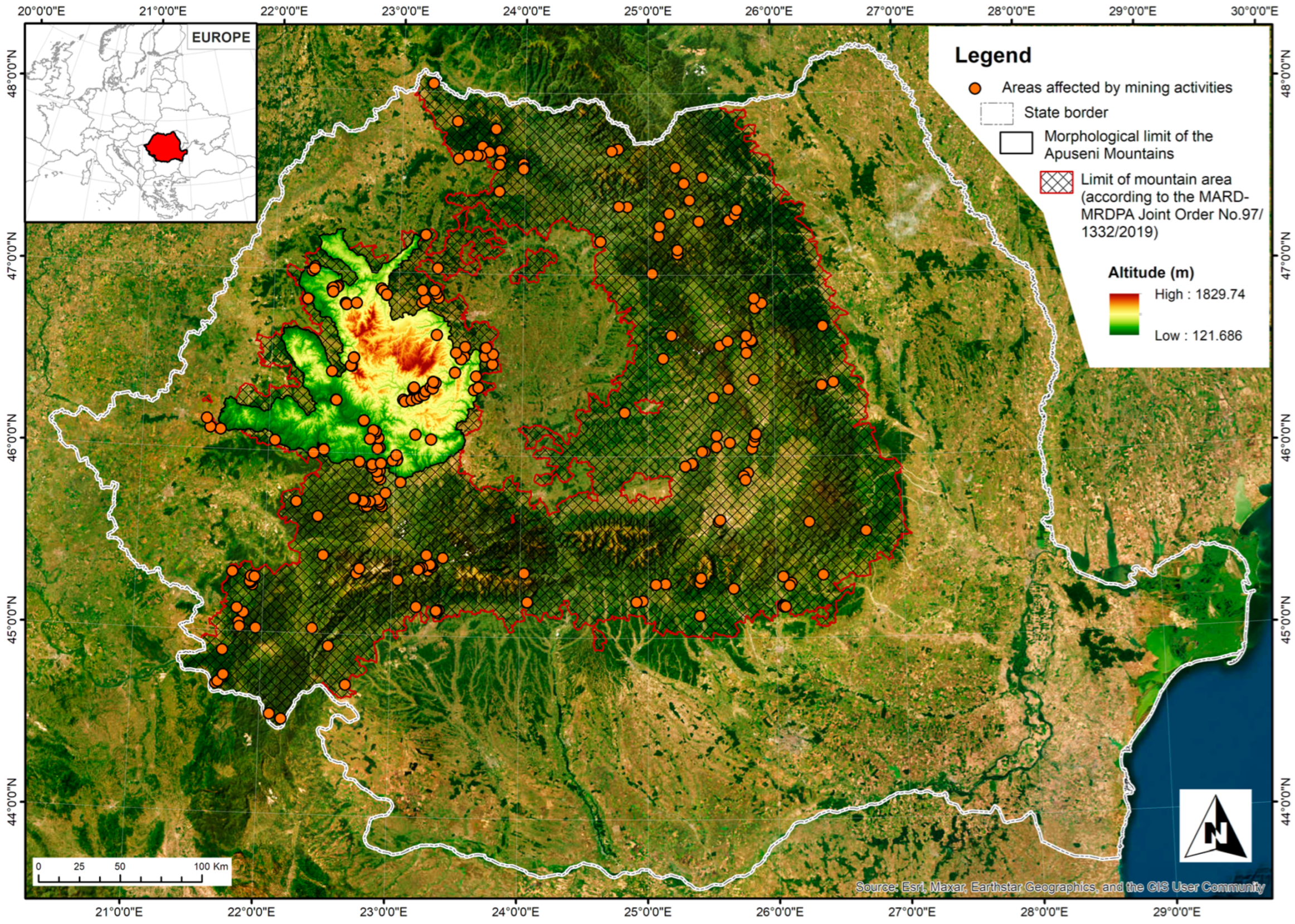

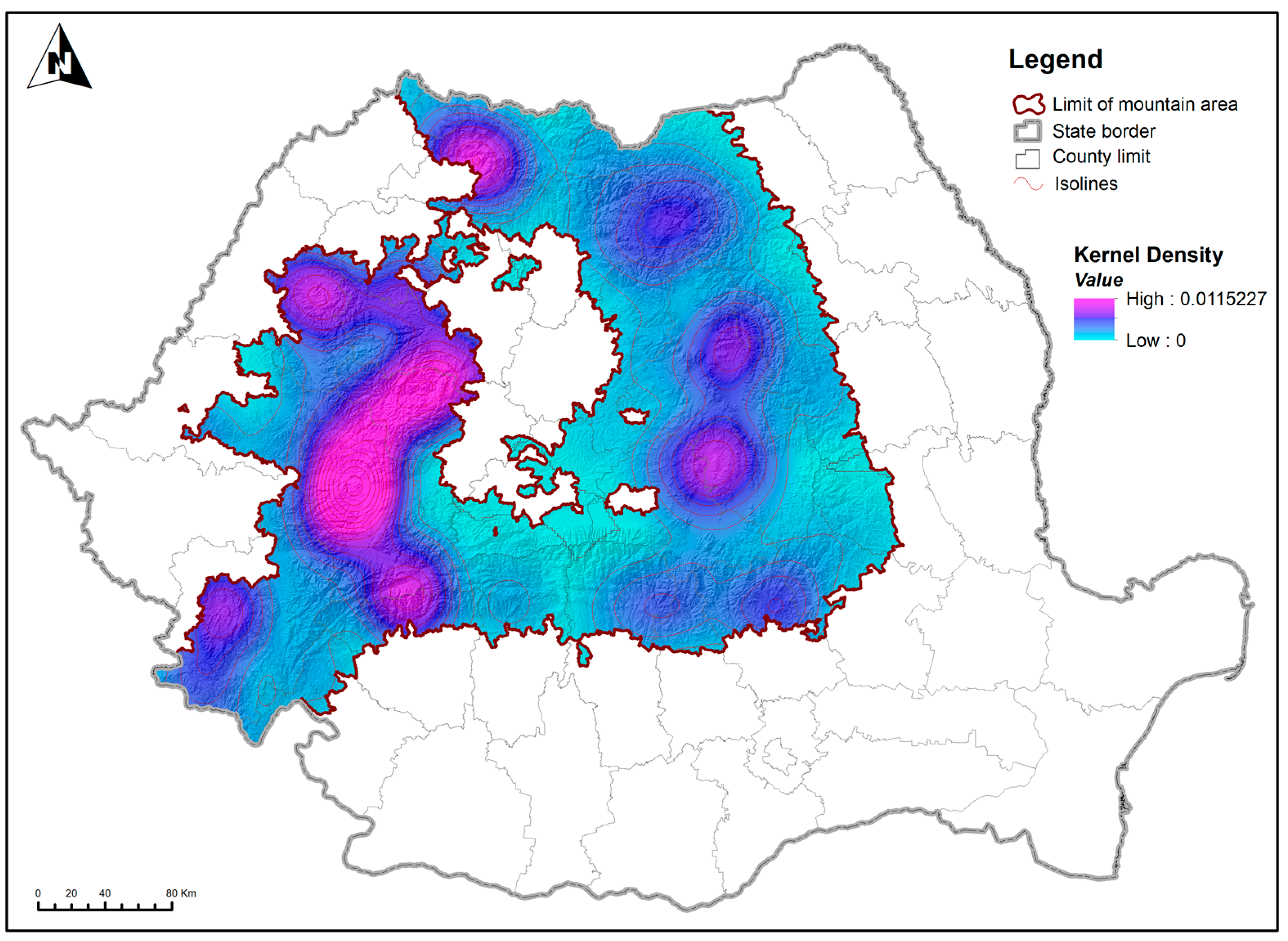
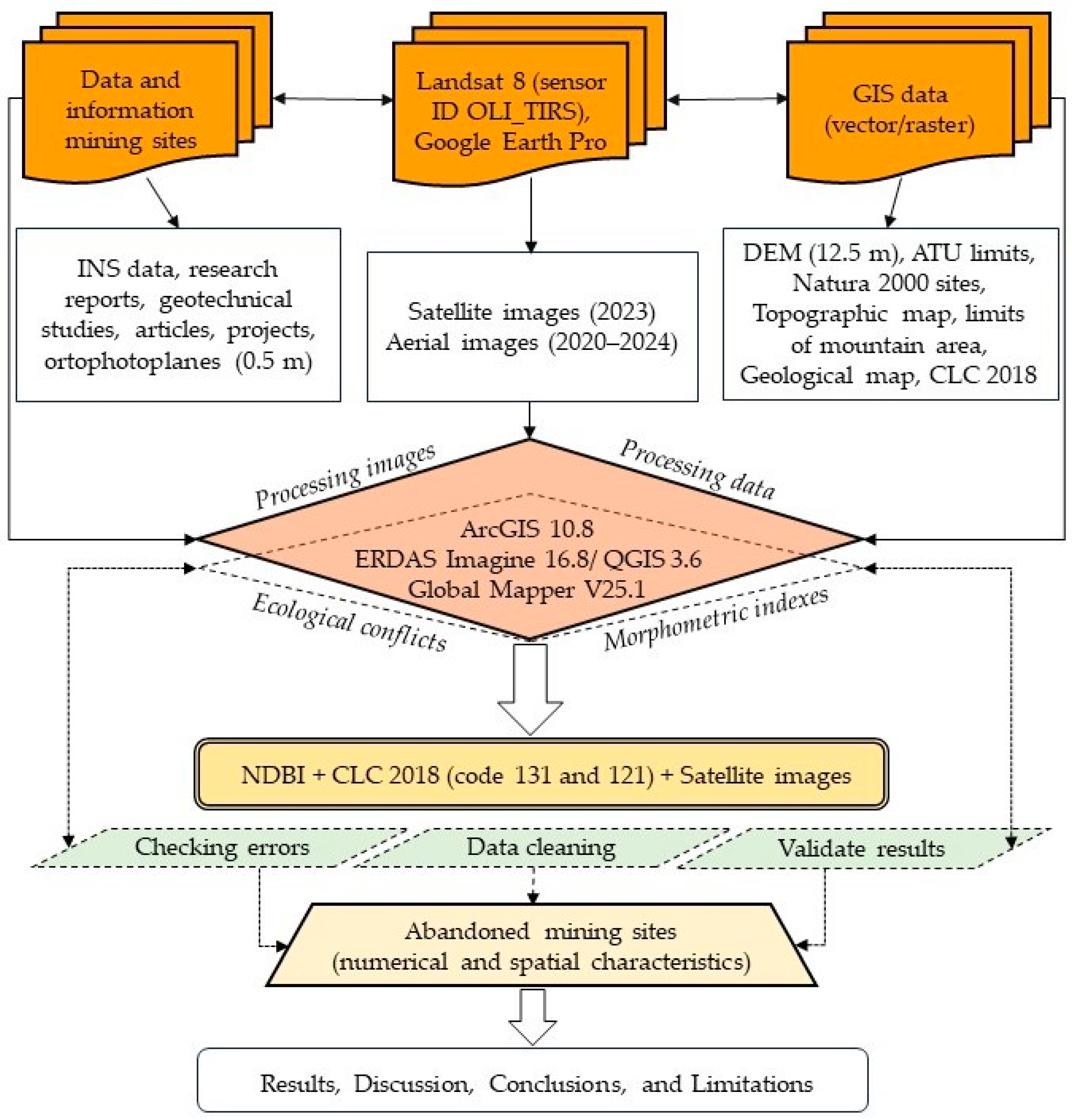


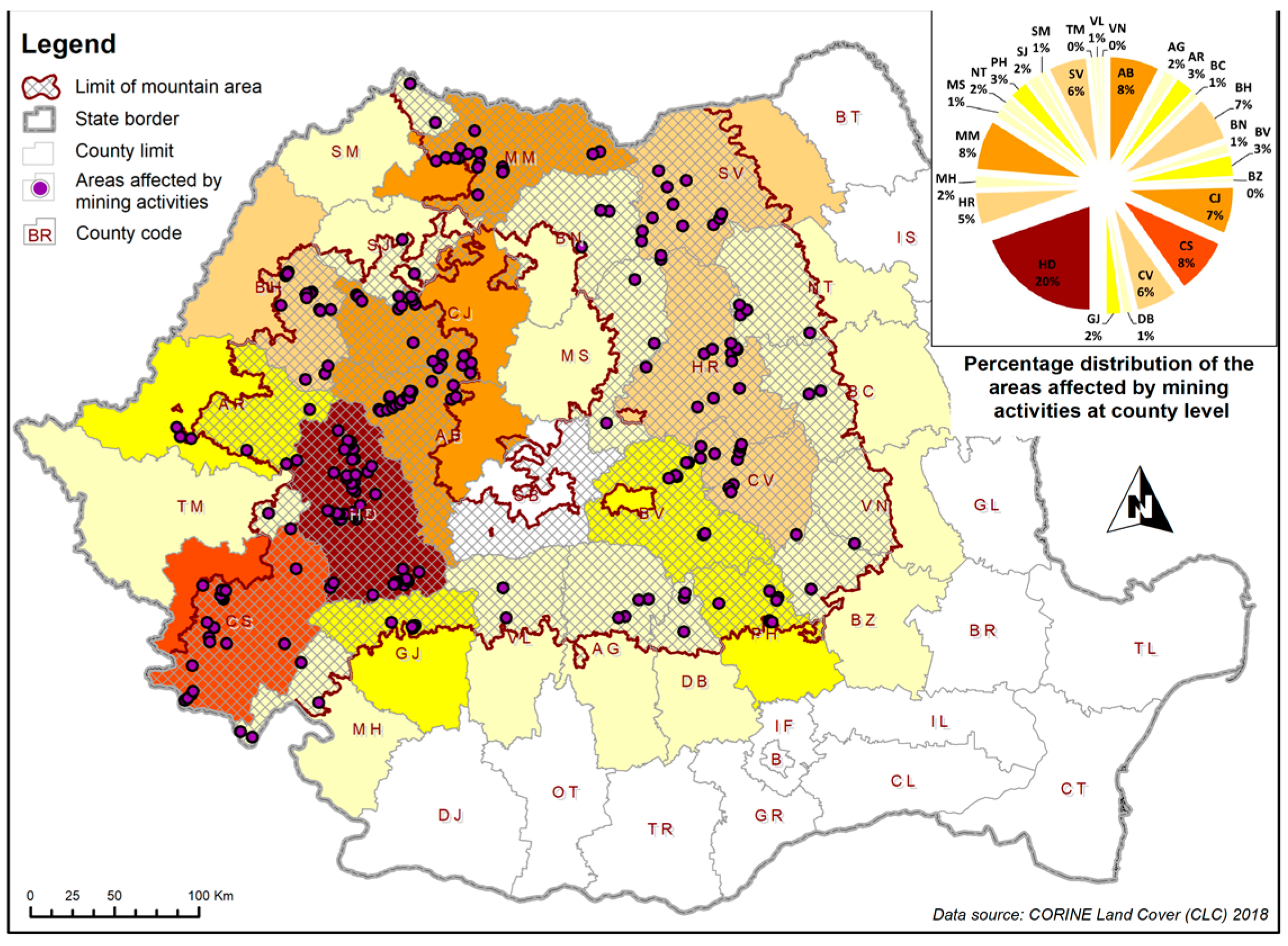
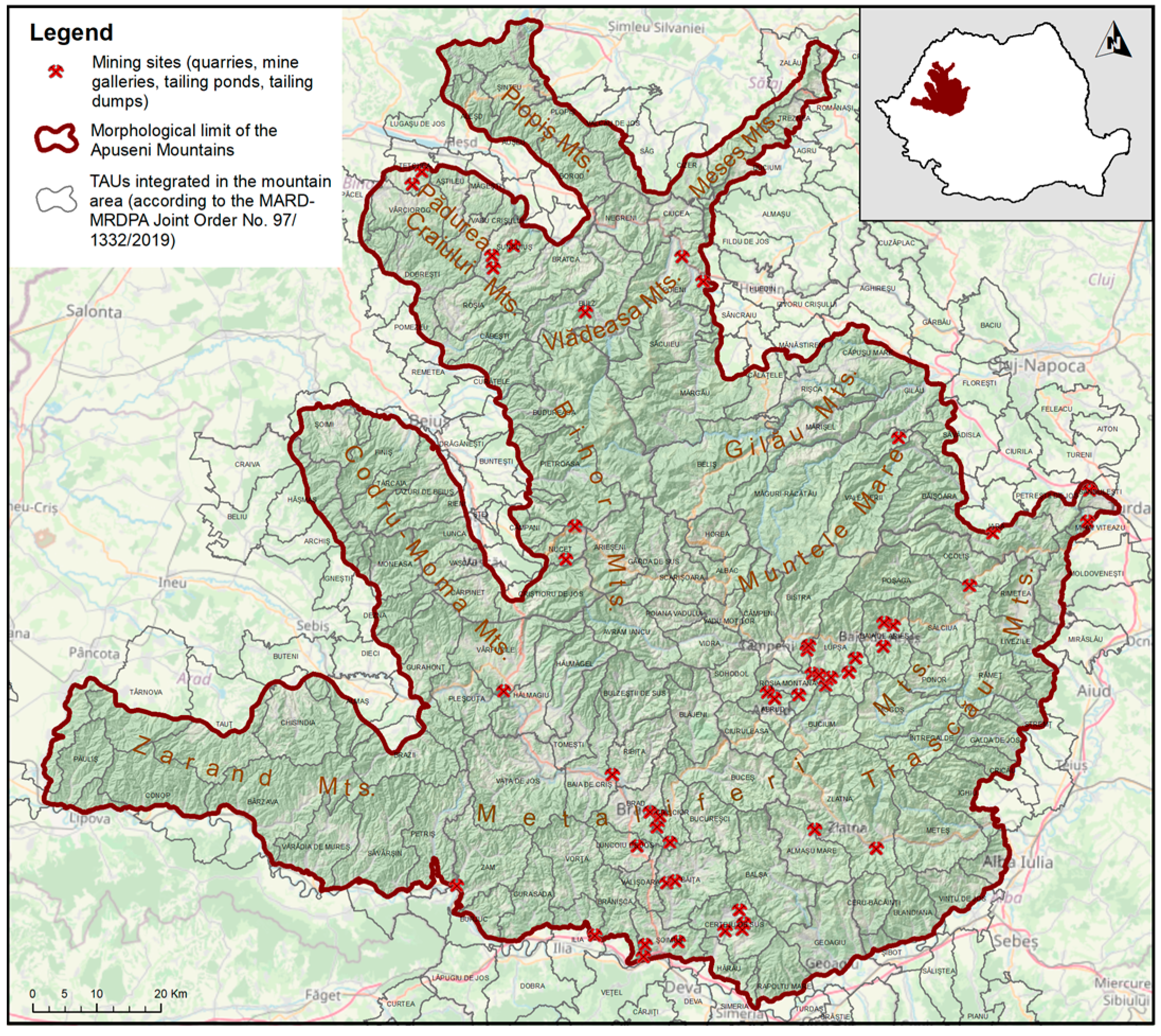

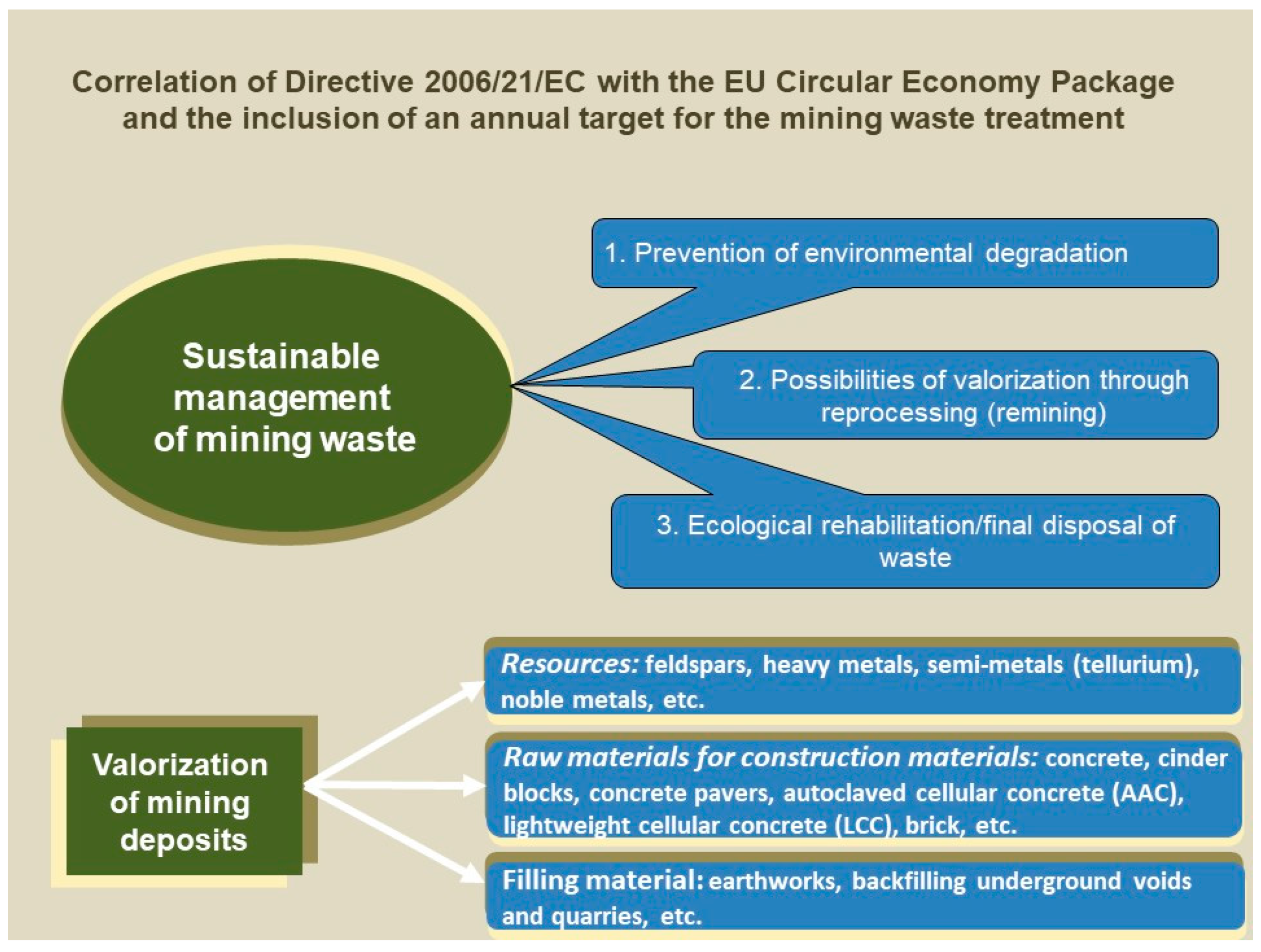
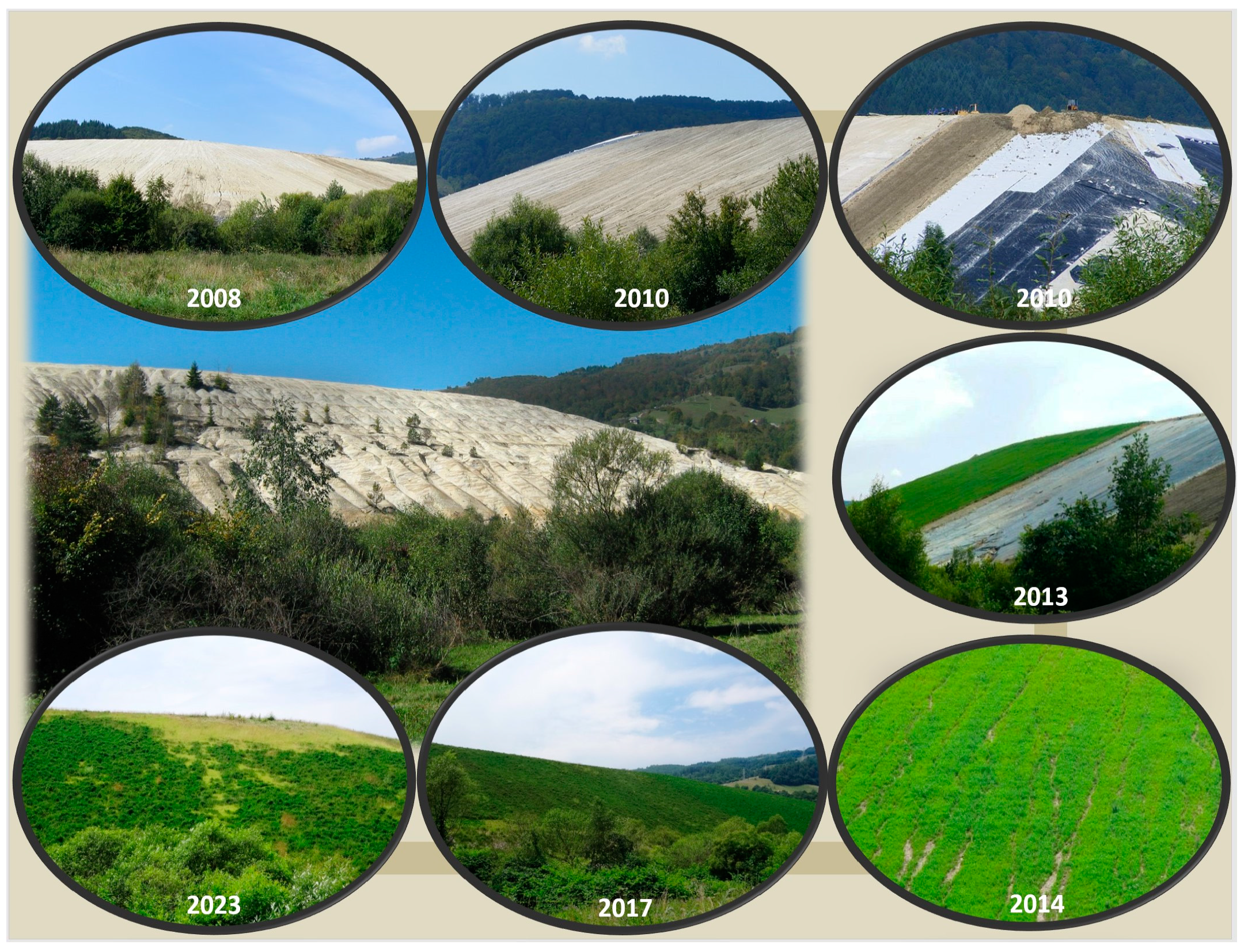
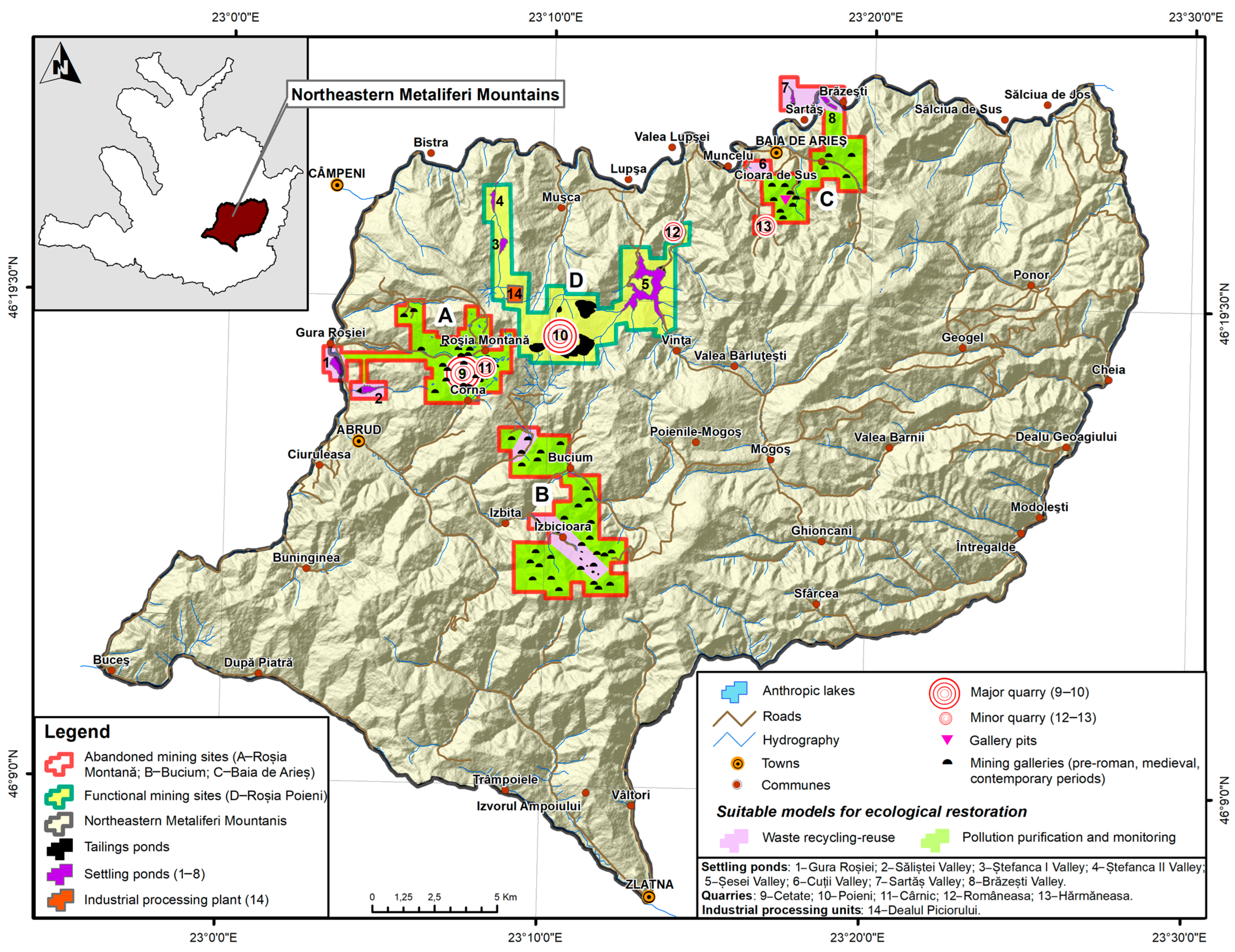
| Layer | Data Format | Data Processing Software | Data Source |
|---|---|---|---|
| DEM 1_12.5 m | raster | ArcGIS 10.8 | ALOS PALSAR RTC |
| TAUs 2 limits | vector | ArcGIS 10.8 | ANCPI 5 |
| Protected areas | vector | ArcGIS 10.8 | ANPM 6 |
| Landsat 8 OLI_TIRS images (2023) | raster | ERDAS 4 Imagine 16.8 | USGS 7 |
| CORINE Land Cover (2018) | vector | ArcGIS 10.8 | EEA 8 |
| INS 3 data | .xml/.csv | Microsoft Excel Version 2406/ArcGIS 10.8 | INSSE 9/ TEMPO-Online |
| Geological map of Romania (1:200,000) | raster | ArcGIS 10.8 | IGR 10 |
| Orthophotoplanes _0.5 m (1:2000) | raster | ArcGIS 10.8 | ANCPI |
| Map of Romania’s mineral resources (1:500,000) | raster | Global Mapper v25.1 | IGR |
| Limits of Romania’s mountain area | vector | ArcGIS 10.8 | MADR 11 |
| Topographic map of Romania (1:50,000/1:25,000) | vector | ArcGIS 10.8 | ANCPI |
| Aerial images (2020–2024) | raster | ArcGIS 10.8 | Google Earth Pro |
Disclaimer/Publisher’s Note: The statements, opinions and data contained in all publications are solely those of the individual author(s) and contributor(s) and not of MDPI and/or the editor(s). MDPI and/or the editor(s) disclaim responsibility for any injury to people or property resulting from any ideas, methods, instructions or products referred to in the content. |
© 2024 by the authors. Licensee MDPI, Basel, Switzerland. This article is an open access article distributed under the terms and conditions of the Creative Commons Attribution (CC BY) license (https://creativecommons.org/licenses/by/4.0/).
Share and Cite
Gligor, V.; Nicula, E.-A.; Crețan, R. The Identification, Spatial Distribution, and Reconstruction Mode of Abandoned Mining Areas. Land 2024, 13, 1107. https://doi.org/10.3390/land13071107
Gligor V, Nicula E-A, Crețan R. The Identification, Spatial Distribution, and Reconstruction Mode of Abandoned Mining Areas. Land. 2024; 13(7):1107. https://doi.org/10.3390/land13071107
Chicago/Turabian StyleGligor, Viorel, Emanuela-Adina Nicula, and Remus Crețan. 2024. "The Identification, Spatial Distribution, and Reconstruction Mode of Abandoned Mining Areas" Land 13, no. 7: 1107. https://doi.org/10.3390/land13071107






